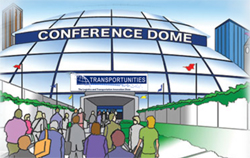 |
August 22, 2014 - Supply Chain Flagship Newsletter |
 |
| SPONSOR: TRANSPORTUNITIES |
||
 |
||
The Logistics and Transportation Insight and Solutions You Need - Without Leaving the Office |
||
October 15, 2014 |
||
 |
|
||||||||||||||||||||||||||||||||||||||||||||||||||||||||||||||||||||||||||||||||||||||||||
Cracking the Gartner Top 25 Supply Chains List
|
|||||||||||||||||||||||||||||||||||||||||||||||||||||||||||||||||||||||||||||||||||||||||||
| GILMORE SAYS: |
"Perhaps more interesting might be not the "best," but rather which companies have made the most improvement over some period of years. " WHAT DO YOU SAY? |
One was a department store chain, the other a consumer goods company.
Being left off the list, it seemed, was both a matter of pride and practicality - top recruits often favor the recognized companies, they told me.
To catch everyone up in case they are not familiar with the list, the former AMR Research brilliantly came up with the top 25 idea in 2004. Gartner then acquired AMR in 2010. Over the last few years, the concept has been extended, so that we now have a "Next 25" list, a top 25 healthcare supply chains, top 10 industrial supply chains, and maybe some others I have missed.
Here, for reference, is this years's top 25:
Gartner's Top 25 Supply Chains for 2014
| 2014 Rank | Company | 2013 |
| 1 | Apple | 1 |
| 2 | McDonald's | 2 |
| 3 | Amazon |
3 |
| 4 | Unilever | 4 |
| 5 | Procter & Gamble | 6 |
| 6 | Samsung | 8 |
| 7 | Cisco Systems | 7 |
| 8 | Intel | 5 |
| 9 | Colgate-Palmolive | 10 |
| 10 | Coca-Cola Co. | 9 |
| 11 | Inditex (Zara) | 12 |
| 12 | Nike | 14 |
| 13 | H&M | 17 |
| 14 | Walmart | 13 |
| 15 | Pepsico | 16 |
| 16 | Lenovo Group | 20 |
| 17 | Starbucks | 15 |
| 18 | 3M | 19 |
| 19 | Qualcomm | 24 |
| 20 | Seagate Technology | Not on List |
| 21 | Kimberly-Clark | Not on List |
| 22 | Johnson & Johnson | 25 |
| 23 | Caterpillar | 18 |
| 24 | Cummins | 23 |
| 25 | Nestle | 21 |
So, if you weren't on this, let's start with the basics: How is the top 25 determined?
Gartner starts with the Fortune 500 list of top US companies by revenue and the Forbes global 2000 list that basically does the same thing on a worldwide basis. It then eliminates a lot of those companies because they do not much operate what most of us would think of as a real physical supply chain - companies in banking, insurance, software, and many more.
As an example, both IBM and Microsoft were dumped from the list a couple of years ago because their services related revenue rose to too high of the total versus their physical product-based sales.
From that culled list, Gartner analyzes publicly available financial data, specifically looking at three metrics:
Return on assets (ROA): Net income / total assets
Inventory turns: Cost of goods sold / inventory levels
Revenue growth: Change in revenue from prior year
ROA and revenue growth use a three-year weighted average, meaning the most recent year gets the most weight and the two prior years somewhat less. Inventory turns, smartly, uses the prior year's quarterly average (reducing impact of end of year games). These three metrics together are given 50% of the total score weight.
So, at this point, you must be a decently large and public company to be considered in the analysis. The smallest company on the Fortune 500 list for 2013 had about $4.9 billion in sales. Private companies would not have the public financial data needed for this part of formula, so they are excluded, meaning for example that perennial list member Dell was not there this year after its was taken private in 2013.
Another 25% of the final rankings come from so-called "peer opinion." In 2014, this consisted of 188 apparently very influential respondents who first select a group of companies from the master list that they believe "are furthest along toward the demand-driven ideal." From those selections, they are then asked to rank those companies from first to last, from which points are assigned to companies.
Interestingly, the reference point, in theory at least, is not "the best supply chain," but rather "demand-driven leadership." Are these the same things? I would say certainly not. But I suspect the panelists in the end are probably really voting based on their perceptions of who had the best supply chains, demand-driven or not. (And yes, being "demand-driven" is certainly an attribute of supply chain excellence, all things being equal.)
So, I assume these respondents largely come from current Gartner clients, but beyond that we don't know a whole lot - and they carry a big stick in the final rankings.
The final 25% comes from votes from Gartner's own supply chain analysts. They in essence use the same tool that the peer group does to rate companies against each other.
Take the financial rankings and the votes from peer group and Gartner analyst group (again, 50%, 25%, and 25%, respectively), and voila, out spits the top 25 based on the numbers.
Is the process perfect? Certainly not. The unstated assumption is, for example, that stellar financial results equals supply chain excellence. So, it is no surprise that Apple has been on top of the list for four straight years, given the massive success of the iPhone and iPad that has led to incredible revenue growth and high margins (which drives ROA).
When and if that growth slows, does that mean Apple's supply chain becomes less good that year? Certainly not, but that would be the effect in this methodology.
Companies that have heavily outsourced production and distribution also have an inherent advantage. Why? Because they have chosen to shed assets, and that drives their ROA metric higher. While outsourcing can be a very smart thing for many reasons, it is not inherently a better supply chain move. This metric also inherently discriminates against asset-intensive businesses, such as chemicals and automotive. That no doubt why we see only three such companies (Caterpillar, 3M and Cummins), in the overall top 25 and probably a big factor in having the separate list of the top 10 industrial supply chains.
Finally, it is biased against sectors that inherently have low inventory turns. A Home Depot or a Lowes, for example, is only going to have turns in the mid-single digits, because of their need to stock every item under the sun to meet customer needs, many of which are very slow movers. Compare that to say the rapid turns at McDonald's, which was number 2 on this year's list, while neither Lowes or Home Depot cracked the top 25.
The methodology also penalizes a company that strategically decides on a higher service, lower turns strategy (even though again, we can all agree that inventory efficiency is a very important attribute of supply chain excellence).
There have been some anomalies over the years. For example, in the very first top 25 in 2004, a Korean steel maker no one ever heard of called Posco gave what admittedly was a fantastic presentation on what it was doing with its supply chain to grow its business earlier in the year at the i2 user conference. Later, Posco magically showed up at a fairly high position on the list for one year - then was never seen again.There have been a few other such oddities.
One thing I am not sure about is the approach for selecting companies to be included in the peer and analyst review process. I do not believe this includes all companies included in the Fortune 500 financial analysis. So, if your company does not make that subjective cut, it obviously has no chance of being considered for the top 25.
So, with all that, here in general is the advice I give: (1) understand the methodology, especially with regard to the financial data. Not much you can really do about that, but you can at least understand how it works and do some comparisons to the top 25 companies; (2) encourage others outside your organization to participate in the peer review process; (3) to impact the peer review ratings, you must go on a (perpetual) campaign to promote your supply chain, as of course Dell did for years; (4) most important, if you are really serious about this, arrange "briefings" with Gartner analysts touting what you are doing in supply chain in the same way that software vendors do it. Ladle on significant helpings of demand-driven-ness. (Shoot me an email if you would like to discuss this.)
As a note, fomer AMR executive Kevin O'Marah wrote a column after the 2014 list saying the process was getting "boring" because the list has such little change from year to year. Indeed, spots 1-4 were unchanged from 2013, and overall there was barely any movement.
I am not so sure about that. Seems to be the best supply chains probably do remain consistent over some period of years. I am just not sure if this methodology really well identifies the top supply chains.
What would I change? It would be admittedly hard to pull off, but I think the financial metrics should be rated on a relative basis. In other words, it would be better to identify stars based on how well they perform versus peers than being fortunate enough to be in a sector with better metrics inherently than others. I am also not wild about revenue growth as a metric.
I would also like to see some approach to identying the best mid-size company supply chains. And to Omara's point, perhaps more interesting might be not the "best," but rather which companies have made the most improvement over some period of years? Which are truly shifting their supply chain curves? More on this soon.
The Gartner top 25 supply chains - it has its faults, but it is the best we've got. I look forward to it every year. It certainly stirs the pot.
What are your thoughts on the Gartner top 25? Do you see any ways it could be improved? Let us know your thoughts at the Feedback button (email) or section (web form) below.
![]()
| View Web/Printable Version of this Column |
|
|
|
YOUR FEEDBACK
We received quiote a few emails - mostly from employees - on our On article on the apparent collapse of the innovative labor pack instituted a few years ago at Spriti Aerosystems, after a new CEO took over from Jeff Turner, who drove the new approach. (See Innovative Labor Pact at Spirit Aerosystems Falling Apart Under Potential Sale of Division, Job Losses.)
That includes our feedback of the week on this topic from the company's Gary Crouse, who offers a balanced view of the situation. Other letters say the original deal wasn't at "win-win" as our piece suggested, though on balance it seems most workers liked the pact. Interesting stuff. Some more of these letters next week.
Feedback on the Week on Collapse of Spirit Laor Deal:
It looks like Larry Lawson doesn't give a flip about the workers, and that's the kind of attitude we have always dealt with, mostly with alarming anger and mistrust. The workers here don't trust management any more than they trust politicians, and with good reason. Last year, several managers that I know, hit the door in an alarming rate to us workers, that they knew what was coming down. So now we're back to mistrusting management again, and we're the ones who haven't changed. If you want good productivity, you need the trust of the workers. When I heard that the union had filed suit and what the company is trying to do (which we don't much) I had to make myself get back to work in the same frame of mind that I normally do. I didn't want to do a thing at all. And if you want the workforce's trust, don't keep things from us, let us know the details before the media does. Keeping things hush hush from us doesn't work and it makes us angry. Gary Crouse |
||
| More on Spirit: | ||
Nothing new here. When the big dog wants a change, a change it gets. Here's the thing - All companies like to and must make money (profit). When the amount they make is below what it should be, due to whatever reason, then changes in operations have and will be made. This must happen in every case or the company will fail. Not a really good idea for anyone. When costs to production increases to point that minor adjustments cannot solve the problem then large adjustments will be made. When the reason is that work performed by their employees falls below that scale which bas been developed and proven to be a valid measuring stick, and the cost to produce an item exceeds that item's value, then changes must be made. When workers production is so low per units manufactured that costs exceed value, changes have to be made. The fix hurts some far more than some others, however that is not a valid reason for the company to shirk it's responsibility to make a profit. The most appropriate fix to the problem and that effects far fewer employees is to accurately identify those whose production falls short of required levels. Those employees need to be terminated and their jobs filled by personnel who will produce to the established standard thusly bringing production costs in balance and allowing a profit to the company. And best of all, for the majority of the employees continued employment. Think about it, would you want to pay someone to do a job for you that should take three hours and takes that employee five hours and costs you almost twice as much as it should. I wouldn't and I don't think you would either. Do it now and do it correctly and lets all get with the program and save our jobs and the company.
R.W. MASTERS
|
||
As much as we distrusted Turner, he pretty much kept his word and worked with the Union, and as an ex Union Shop Steward I know this to be true. However since "Lawless Lawson" took the reins, its been a different story. Management talks the talk of needing worker input, worker ideas, worker spotting problems and advice on a solution since we are the "Process Experts" and have the most knowledge. When it comes to implementing his talk, its all talk, we are told there is no money for small changes, to fix equipment, tools, etc.... Yet we have millions of $'s on hand, thus the high stock prices, but things continue to fall apart and be done the same old ways, costing us money that L.L. says we need to be saving. His solution is the "Old fashioned way", sell off, lay off, look for excuses to fire, etc..... Then wonder why moral is in the dumps.... Get rid of L.L., bring in someone like, but not exactly like, Turner, finish turning this place the rest of the way towards a new future of doing things, cut the BIG Boys salaries they don't earn and limit bonuses to only when the do earn them.
John De Armond
|
||
This company used to be family-owned. Now it's only about the rich getting richer. The hell with the middle class people that keep the jerks pockets filled! The Union will win and the company will end up failing and taking a huge loss like usual. People need to realize that the whole town of Wichita will take a huge hit if they continue to contract jobs for cheap unqualified workers. Spirit is falling apart and that won't change until someone stops the Lawsons and Turkles of the company! They receive the 1 million dollars or more in bonuses while the real people suffer. The people will get even, it's just a matter of time!
Bill Smith
|
SUPPLY CHAIN TRIVIA ANSWER
Q: Six carriers/logistics service providers made the 2014 Fortune 500 list of largest US companies – which are they?
A: UPS (50), FedEx (64), CH Robinson (220), Expediter's Int'l (425), JB Hunt (454) , ConWay (464).
| © SupplyChainDigest™ 2003-2014. All Rights Reserved. SupplyChainDigest PO Box 714 Springboro, Ohio 45066 |
POWERED BY: XDIMENSION
|










